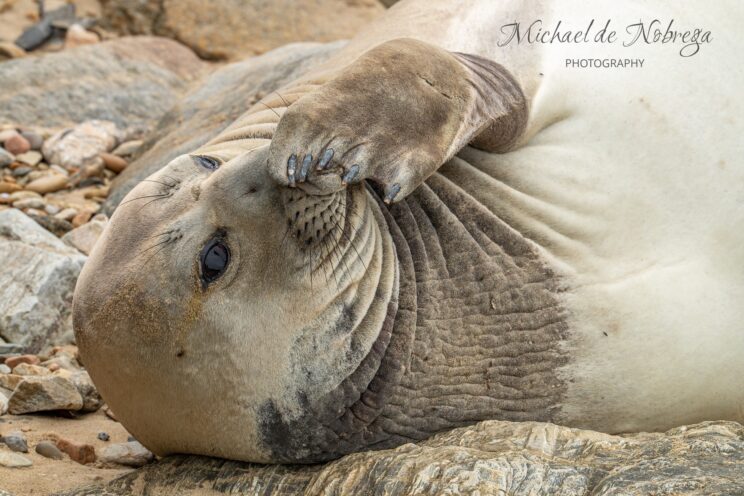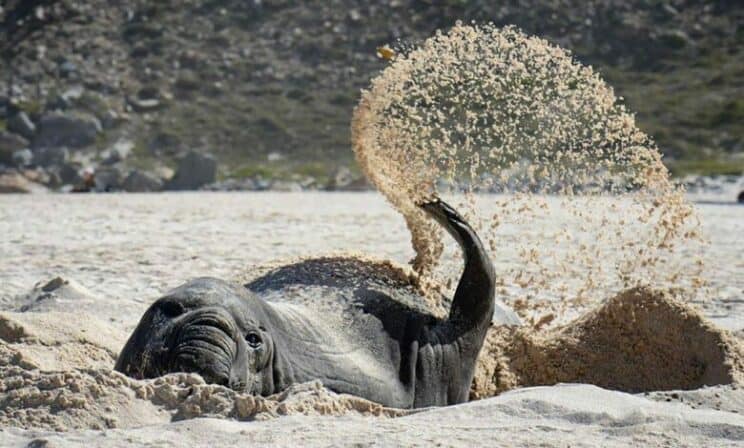Video
GARDEN ROUTE NEWS - Southern elephant seals are rarely seen on South African shores. Native to the remote Southern Ocean, these massive marine mammals – the largest of all seals – are usually found lounging on Sub-Antarctic islands.
Yet, since November 2023, a sub-adult male nicknamed Columbo has been quietly making history, visiting one Garden Route destination after another.
In the process, he has become a beloved, if unlikely, coastal celebrity. Columbo is one of a few southern elephant seals that regularly visit the Cape’s beaches.
The appearance of Columbo is more than a novelty; it provides a valuable opportunity to educate the public on how to coexist respectfully with wildlife.
Each sighting of Columbo has sparked excitement among residents and marine conservationists alike, not just because of his species, but due to the unique journey he’s embarked upon.
Val Marsh from Stranded Marine Animal Rescue Team (Smart) posted on Facebook yesterday that Columbo first arrived in Dana Bay in November 2023, where he settled for a three-week moulting period – an essential but vulnerable phase in a seal’s life.
Since then, he’s been spotted in Pinnacle Point, Victoria Bay, Herolds Bay, the Kaaimans River, Knysna, and as far west as Jongensfontein near Stilbaai.
Yesterday, Columbo was spotted in Victoria Bay and the Smart team was on hand to monitor him.
Watch: Columbo spotted yesterday. Video: Michael de Nobrega/Facebook
 Columbo spotted yesterday. Photo: Used with permission from Michael de Nobrega
Columbo spotted yesterday. Photo: Used with permission from Michael de Nobrega
Watch: Columbo the elephant seal visiting all the way from Antartica
In January, Columbo was found resting near Jongensfontein. Smart took the opportunity to administer a rabies vaccination. This was no ordinary jab as Columbo became one of the few southern elephant seals globally to receive the vaccine, as a precautionary measure due to the growing incidence of rabies among Cape fur seals, with which elephant seals can interact.
The vaccination was administered by Dr Anthony Creighton and Sister Stefanie de Graaff of Hartenbos Animal Hospital, marking their first time vaccinating such a large and powerful marine mammal.
Southern elephant seals are dangerous animals, and because of their size, it can be difficult to work with them, the Hartenbos team explained. After a difficult five-hour journey and plenty of community help, including getting their vehicle unstuck from sand twice, the team was able to vaccinate Columbo successfully.
Columbo’s movements have continued to capture attention. In April 2024, he was seen lounging in Herolds Bay and later back on the rocks at Victoria Bay, appearing well-fed and now carrying a few battle scars – signs of the wild life he leads. By May, he had returned to Knysna, his likely ‘haul-out’ spot, where seals stay on land during their moult. Ocean Odyssey Knysna noted that moulting seals are protected from the cold not by fur, but by thick layers of blubber, making dry, undisturbed haul-outs critical for their survival.
“If only he could talk,” Marsh mused. “He could write an extraordinary travelogue!”
Buffel in Hermanus
In February last year, Caxton Network News wrote about Buffel, another southern elephant seal.
At the time, Buffel had decided to go ashore in Hermanus for his annual moult.
 Buffel, the elephant seal. Photo: Danel Wentzel.
Buffel, the elephant seal. Photo: Danel Wentzel.
Buffel has been seen around many of the Cape’s beaches over the past few years and is identifiable by a scar above his left eye and a flipper tag (#16577).
According to an article published on the Cape of Good Hope SPCA’s website, it’s rumoured that Buffel was born on Cape shores to a displaced mother.
The SPCA says Buffel has come ashore to moult on Cape Town beaches, from Llandudno to Fish Hoek, for several years.
“Most haul-out sites are on Sub-Antarctic and Antarctic islands, which makes sightings of Buffel even more exciting.”
Read more on Caxton Network News
‘We bring you the latest Garden Route, Hessequa, Karoo news’
















